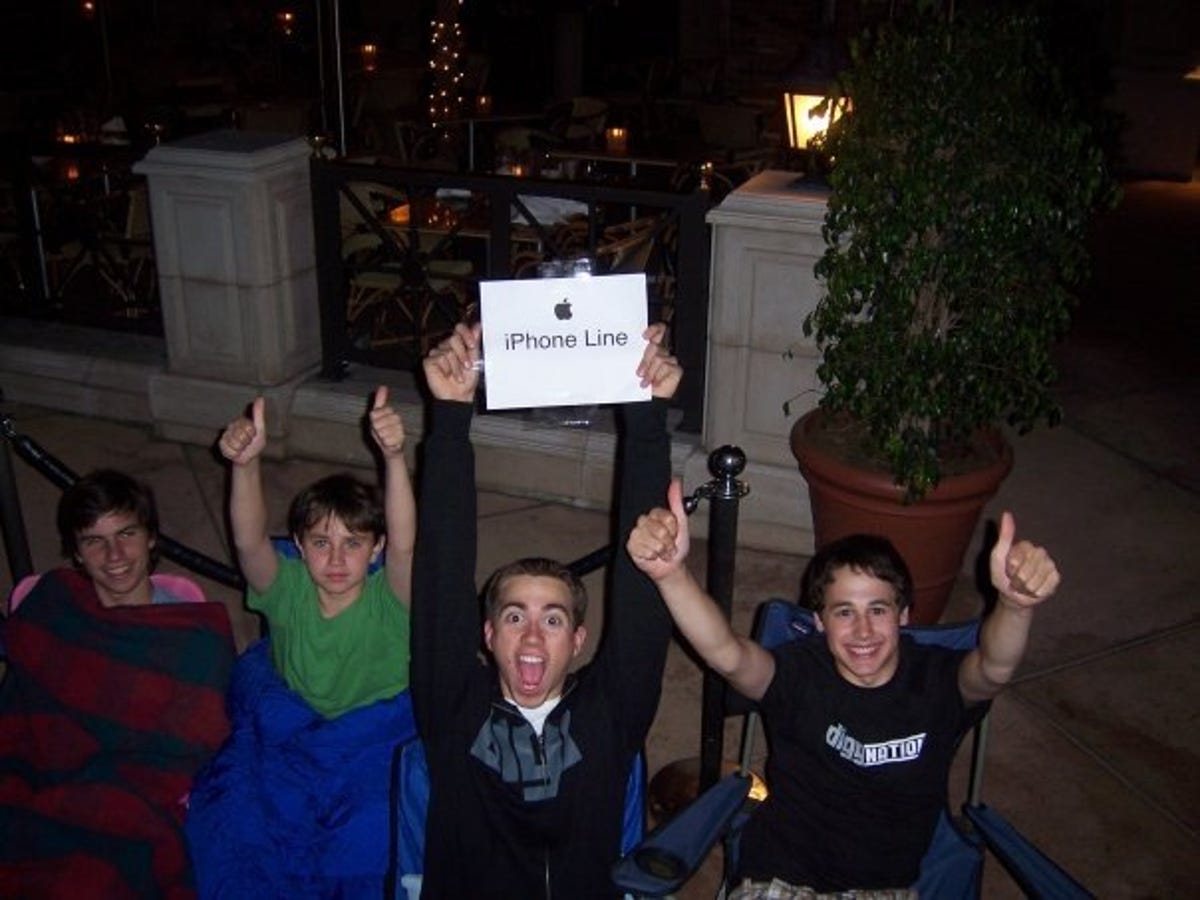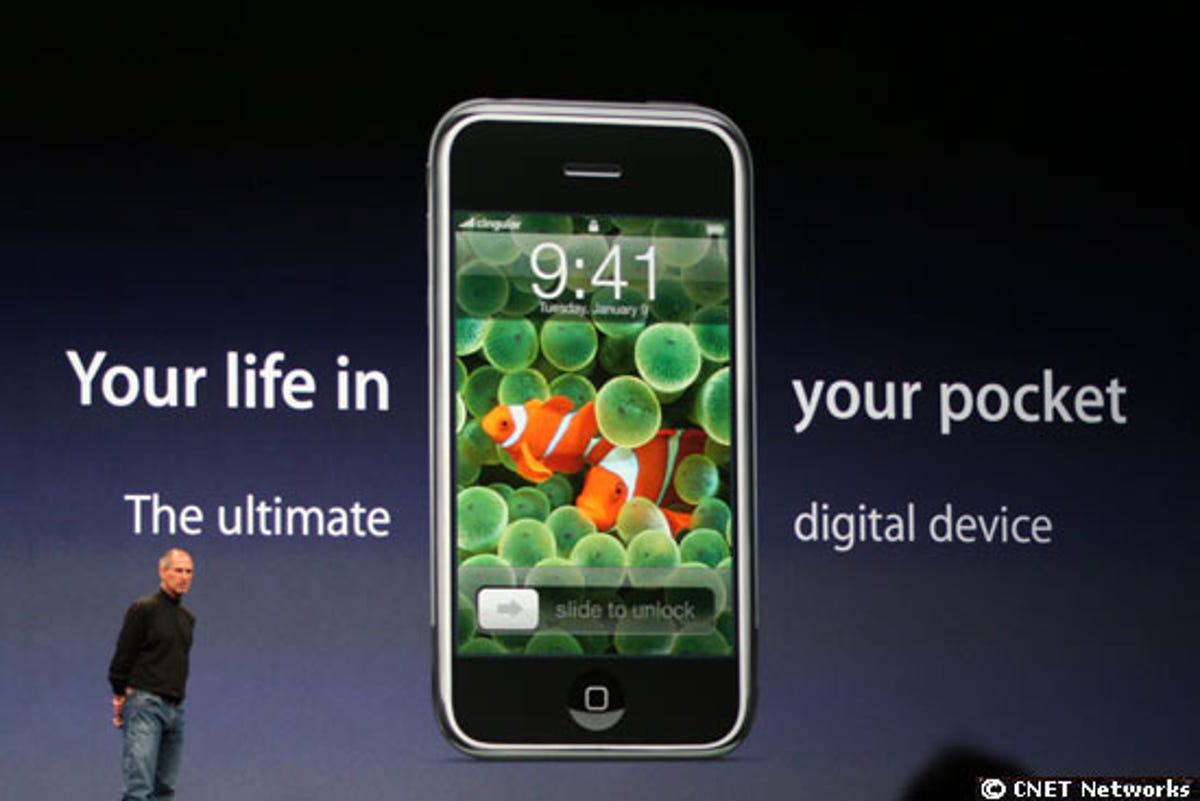
Courtesy of Jeremy Bachrach
Seven years ago, Jeremy Bachrach, then a 17-year-old high school student, waited in line outside a mall in Thousand Oaks, Calif., with his 12-year-old brother Harry. They’d been there for more than 24 hours to get their hands on Apple’s original iPhone.
“I was pretty stoked,” recalled Bachrach, now a real-estate investment analyst. “At the time it met nearly all my expectations.”
It was the start of what’s become an annual tradition: Fanboys lining up for hours — or sometimes days — at their local Apple store to be one of the first to walk away with the latest iPhone.
That waiting-in-line-to-buy-a-new-Apple-gadget phenomenon, a spectacle few other companies can boast of, underscores the appeal and importance of the iPhone. There will undoubtedly be lines when Apple unveils the iPhone 6, the eighth generation in the franchise, sometime in the fall. In a field where the term “game-changer” is trite, few dispute that it can rightfully be applied to Apple’s marquee product, which has been hailed as the one, the true “Jesus phone.” In the past seven years, Apple has sold more than half a billion iPhones.
Unveiled in January 2007 by former Apple CEO Steve Jobs and sold in the US starting on June 29 that year, the iPhone changed people’s perceptions of a mobile phone and what it could do. Before the iPhone, one of the most popular handsets was Motorola’s Razr flip phone. Apple’s touchscreen-based device, unique at the time, propelled the computer maker into its current position as a consumer-electronics juggernaut — and helped Apple become one of the most valuable companies in the world.
A year later, when Jobs allowed outside developers to create programs for its smartphone, Apple launched a new economy centered around mobile apps. Even if the iPhone franchise has lost some of its sizzle over the years as competitors including Samsung offer glitzy alternatives, there’s no understating the importance of the iPhone.
iPhone at 7: How it changed everything (pictures)






“As far as disruptions go, this is as big as it gets and as fast as it gets,” said Horace Dediu, founder of tech-market analyst firm Asymco. “The PC did disrupt a lot of industries, but it took 20, 30 years. The iPhone did it in less than 5.”
A foregone conclusion — not
While it’s easy to see the iPhone as a cultural and technological milestone today, it wasn’t an immediate slam dunk at the time. There were plenty of skeptics who questioned whether Apple, known as the maker of Mac computers and iPod digital-media players, could crack into the ruthless world of mobile phones. Apple had also locked itself into an exclusive agreement with AT&T, employing a unique model that gave it a cut of each month’s wireless bill.
As a result, the initial price of the iPhone was $499 for a 4-gigabyte model and $599 for the 8GB one.
That’s sky-high even in today’s market, which benefits from carrier subsidies that keep smartphone prices artificially low (A 16GB iPhone 5S with a contract costs $199, while an off-contract device costs $649). When Apple discontinued the 4GB model in September 2007 and slashed the price of the 8GB version to $399, investors got jittery.
Such a dramatic price cut was unusual for Apple, and investors hadn’t gotten any guidance on sales beyond the 270,000 units sold in the first 30 hours.


Courtesy of Alan Braverman
In comparison, Apple sold 9 million iPhone 5S and 5C units over its first weekend in September 2013.
Still, for those first buyers, playing with the iPhone for the first time was unforgettable. “I was full of excitement and probably bragging that we had camped out all night and were nerding out,” Alan Braverman, 41, of San Francisco, said of his first moment after snagging the original iPhone. “If there was an easier way to get one, I certainly wouldn’t have cared.”
‘Angel sounds coming out of the box’
Ashley Huffman vividly remembers savoring her first moments with the her first iPhone several years ago — opening the box, surveying each component, even reading the manual. “You kind of feel like there’s angel sounds coming out of the box,” the 31-year-old Toronto marketing manager said.
Her first iPhone, however, wasn’t the original, but the second version, the iPhone 3G, which debuted in June 2008.
The iPhone franchise arguably took off with the launch of the iPhone 3G, which fixed several nagging issues. Apple struck a more traditional subsidized deal with AT&T to bring the smartphone’s base model price down to $199 (with a two-year contract). It also added a faster 3G connection, clearing up one of the bigger annoyances with the original model.
But it was the advent of the App Store and the ability for third-party developers to easily build apps and games for the device that really revolutionized Apple’s position in the mobile world. People may have jumped on the Apple bandwagon because they liked the phone, but they stuck around for the apps. It’s a big part of why other mobile operating systems such as BlackBerry and Windows Phone have struggled to win new customers — the lack of key apps consumers have grown accustomed to owning.
Despite the rise of Google’s rival Android mobile operating system, Apple’s App Store is still considered the premier destination for developers. There are now over 1.2 million apps in the App Store, with 800 apps downloaded every second.
Huffman still has her iPhone 3G in a keepsake box as a reminder to develop simple and elegant concepts at work. But she no longer uses an Apple smartphone. Huffman recently switched to a Samsung Galaxy Note 2, saying it’s more adaptable and easier to personalize.
iPhone begets better competition
In terms of the kind of smartphone experience the iPhone delivered, Apple enjoyed a long lead over its rivals. When Google unveiled its G1, the first Android smartphone, in the fall of 2008, it was considered more of a novelty.
Customers didn’t take much notice of an iPhone challenger until Verizon Wireless — looking for a counterpunch to AT&T’s exclusive hold on the iPhone — backed Google and Motorola’s Droid in a massive marketing campaign. But a true rival didn’t emerge until Samsung Electronics put its resources behind its own flagship Galaxy S franchise, combining high-end specifications with clever marketing to draw attention.
Apple has since ceded the crown as the top-selling smartphone maker to Samsung, and Google’s Android now powers more than 80 percent of the world’s smartphones. The iPhone faces more competition from a stream of new smartphones, with Samsung pressuring Apple in the high-end market and inexpensive-phone makers such as Huawei and ZTE gaining ground in the low-end.
RELATED LINKS
- iPhone 6 rumor roundup
- Samsung exec: People aren’t fooled by Apple anymore
- iPhone turns 4: Early predictions rewound
This month, online retailer Amazon unveiled its own device — the Fire Phone — adding another major name to the smartphone race.
At the same time, Apple has gotten dinged for releasing incremental updates to each new iPhone. When the Siri voice navigation service was announced with the iPhone 4S in October 2011, it became a short-lived novelty with limited practical use. Even the fingerprint reader Apple added to the iPhone 5S has not yet proved to be a significant addition to smartphone devices.
When asked for comment, Apple pointed to several statistics showing the influence and success of the iPhone.
Bachrach, now 24 years old and living in San Francisco, said that while he remains an iPhone customer he hasn’t felt the same amazement about his newer iPhones. “I think they lost their ‘it’ factor, whatever that was,” Bachrach said. He thinks Apple’s leaders need to take more risks to excite customers.


Declan McCullagh/CNET
iPhone still a juggernaut
That’s not to say the iPhone is in decline.
Apple in fiscal 2013 sold more than 150 million iPhones, which accounted for $91.3 billion in sales. That’s more than half of Apple’s total revenue. Consider that in fiscal 2008 — its first full year of iPhone sales — Apple sold just 11.6 million iPhones, generating sales of $1.8 billion.
As of late April, over 515 million iPhones had sold across the globe. Apple claims more photos are taken now using the iPhone than any camera. The device also helped birth a movement away from regular feature phones toward smartphones, with the Internet-equipped devices now accounting for 70 percent of mobile phone users in the US. That’s up from about 5 percent before the iPhone launched, according to Asymco’s Dediu.
The iPhone maintains a coveted place in the market, said BTIG tech analyst Walter Piecyk, as the device is able to maintain industry-high gross margins, reported by IHS to be as much as 70 percent. In addition, Apple’s iOS software, which powers both the iPhone and the iPad tablet, remains a leading platform for developers eager to tap into Apple’s well-heeled customer base, he said.


Courtesy of Samantha Lambert
Samantha Lambert has upgraded to a new iPhone nearly every year after falling in love with the design of the original device. The Manhattan resident keeps her iPhone in bed with her when she goes to sleep and it’s the first thing she looks at when she wakes up. She has a waterproof docking station so she can use the phone to listen to music while in the shower and carries it with her to set her calendar and send text messages throughout the day.
“It’s essentially a part of me,” said Lambert, a human resources director. She can’t “fathom” owning a different kind of phone.
To help keep the iPhone its top moneymaker, Apple is widely expected to release two new iPhone 6 models, both with larger screens than the current 4-inch display, to keep up with a trend of bigger smartphones hitting the market. Apple CEO Tim Cook also promised the company would launch new products in 2014, as Apple has faced pressure from investors to diversify beyond the iPhone and iPad into new markets, such as wearables and smart TVs.
“Right now they are doing a good job,” Piecyk said. “They have a loyal customer base. They’ve got a good ecosystem.”
But some still long for the company to again reach that moment of revolutionary design captured in the first iPhone. “The competition is fierce,” Huffman, the Toronto resident, said. “If they don’t find a way to reconnect with the former audience of people who love them because of the innovative nature of their devices, then other companies are just going to come in and do things better and faster.”



